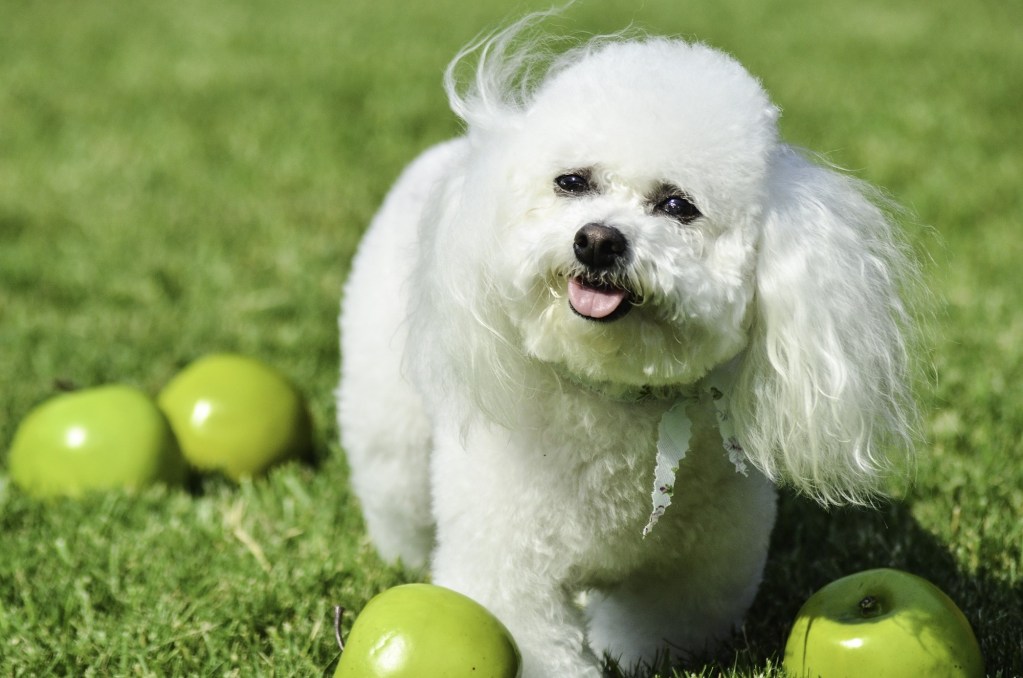Although dogs are renowned meat lovers, a balanced diet is essential for the health of your pet. They shouldn’t eat only protein. Fruit is one food group that’s often overlooked when it comes to canines, though many fruits — like apples — are actually wonderful additions to mealtimes and treat menus.
Can dogs have apples? Are apples safe for dogs? We get it — you have questions. In this article, we’ll review everything you need to know about feeding your dog apples, so by the time you’re done reading, you’ll feel ready to hit the grocery store.
Are apples safe for dogs?

Yes, apples are a safe snack for our beloved furry friends. Whether we share our fruity treat or incorporate apples into our pet’s diet, they’re a great source of nutrients as well as a delicious snack. In fact, many dogs will be thrilled to have bite-sized pieces of apple as a treat instead of your normal store-bought or homemade dog treats.
Even the skin of the apple is safe for dogs to digest, though high amounts of these peels can lead to digestive upset (that’s fiber for you). Still, don’t worry if you don’t peel every single piece before letting your pup snack away. The two parts of the apple that are not safe for ingestion by dogs are the core and the seeds, so make sure to cut these out before serving. Other than that, you’re good to go.
The pet health pros at Purina recommend a daily serving of one or two apple slices for a dog. Generally speaking, treats shouldn’t exceed more than 10% of your dog’s diet each day.
Can dogs have all varieties of apples?

Good news! All varieties of apples are safe for your dog to eat when prepared correctly. This may come as a surprise due to the intense tartness of some apples, like Granny Smith, but the Purina experts assure dog owners of this every day.
“Dogs may not consume tart flavors,” warns Karina Carbo-Johnson, MS, “but if you have a favorite variety, try sharing a piece with your dog.” Their flavor preferences may surprise you. There are some food-motivated dogs that would try any kind of apple, without question, but there are also many others that are picky about taste and texture. Sometimes, trial and error is the only way to find out what your dog likes best.
Nutritional value of apples for dogs

Not only are apples sweet and delicious — that’s something both you and your dog can agree on — they’re full of vitamins and nutrients, too. Like many fruits, apples are fantastic sources of vitamins A (this supports healthy canine vision, bones, and immune systems) and C, which reduces inflammation and encourages brain health.
Do you know which part of the apple contains the most fiber? It’s the skin. This may be one reason not to peel every last inch of an apple when sharing with your pup, especially if they need the extra digestive boost. Just be careful not to let them have too much fiber.
Another reason pet parents love apples as a snack for their dogs is that this fruit is exceptionally low in fat. There isn’t much protein to be found in this snack, either, so it surely won’t suffice as a meal. The good news is that it won’t spoil their appetite, either.
Apples do, however, have a decent concentration of fructose, the naturally occurring sugar in most fruits. This type of sugar doesn’t have the greatest effect on people, and it can raise blood sugar in animals, too. This can be especially dangerous for dogs with diabetes, so consider this one more reason to stick to moderation.
How to prepare apples for dogs

Now that you know the basics about dogs and apples, it’s time to learn how to prepare them for your furry friend. No matter which method you choose, remember to wash your apples, too.
- Sliced: If you’d rather keep it simple, all you truly need to do is wash and chop your fruit, making sure to remove any remnants of the core or seeds before handing your pup some appropriately sized pieces. If your dog tends to wolf down whatever food is in front of them, try smaller pieces of fruit. Those that like to chew their food will do well with a slightly larger piece to gnaw on.
- Frozen: On a hot summer day, a slice of frozen apple can keep your pup entertained and satisfied for a while. You’ll definitely want to chop up your fruit before freezing for both convenience and necessity — frozen fruit can be nearly impossible to cut. You can also put apples and other dog-safe fruit (or even frozen yogurt) into a food processor to make yummy dog-friendly popsicle treats.
- Dehydrated: Dehydrating thin apple slices is another way to add fruit to your fur baby’s diet. All you need to do is heat these slices at a low setting (try 125 degrees) for a few hours (either an oven or a food dehydrator will work). This will result in a soft, chewy treat that’s similar to jerky. You may even be tempted to try a piece yourself.
Whether you like to incorporate apples into your dog’s meals or they’re a favorite treat in your home, keep on doing whatever you’re doing — you’re good. If you haven’t tried apples with your dog yet, they’re always an option for a new tasty snack. Keep an open mind. Luckily, not much prep is needed when preparing apples for your pup, so it’ll take only a minute when you do decide to try it. Your pup just may find a new favorite snack.




